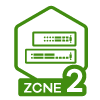NWA210/220AX Port Names and Settings

Hi!
Neither in the manual nor in the FAQ or community I can find an understandable version how the ports in the NWA210AX/220AX are named and work.
Externally they are named "UPLINK" and "LAN1". In Configuration/Network/VLAN/Port Settings only a port named "lan1" can be configured. And there are only two parameters changeable: active/inactive and PVID. I wonder if these settings apply to the external port "LAN1" or to "UPLINK" or to both of them.
Same with Configuration/Network/VLAN/VLAN Configuration: Only the port named "lan1" can be set as a VLAN member. And ist must be set, because otherwise an error is shown that at least one member must be set. Here only three parameters can be set per VLAN: enable/disable, VID and Tx tagged/untagged. For 220AX you even cannot set Tx tagged/untagged explicitly. It's derived from the port lan1 setting PVID. So again I wonder if these settings apply to the external port "LAN1" or to "UPLINK" or to both of them.
Unfortunately there is no documentation available for that, because the manual only explains the settings somewhat, without referring to the physical ports of the various devices.
Can anybody explain the behavoir of both ports in relation to the settings?
Cheers, Holger
All Replies
-
Hi @Sumpfstrauch ,
The "UPLINK" port is used to connect the AP to your network. This could be a connection to a router, a switch, or another AP. While the "LAN1" port is typically used to connect other devices to your AP. For example, you might connect a computer, a printer, or another network device to the LAN1 port.
In the Configuration > Network > VLAN > Port setting / VLAN Configuration, the settings you adjust for "lan1" apply specifically to the "LAN1" port.
Please refer to this FAQ to know more about Uplink and LAN1 ports:
Zyxel_Judy
1 -
Hi Judy,
for some reason, the forum ignores my following comment when posting, so I have to split it up.
thank you so much for your really quick answer. According to the docs and FAQ I'd also assume that the SW config of "lan1" relates to the config of port "LAN1" only. But that's why I do not understand how port "UPLINK" is working. I cannot find dedicated settings for "UPLINK". Let me concretise the question in detail.
0 -
Reading the docs I assume for UPLINK:
- Incoming: tagged frames are bridged to WLANs and LAN1 corresponding to the WIFI and "lan1" settings
- Outgoing: WLANs and LAN1 are bridged with tagged frames to UPLINK corresponding to the WIFI and "lan1" settings
0 -
Question 1: What happens with untagged incoming frames (what is the PVID of UPLINK)?
- Variant 1: untagged frames are dropped
- Variant 2: PVID of UPLINK is always "1"
- Variant 3: PVID of UPLINK is equal to the management VLAN ID
- Variant 4: PVID of UPLINK is taken from "lan1" PVID settings
0 -
Question 2: In which case are untagged frames emitted on UPLINK?
- Variant 1: never - all frames on UPLINK are tagged always
- Variant 2: all PVID frames are untagged (PVID according to question 1)
- Variant 3: Something different which I don't know 😊
Can you answer these two questions or guide me to the answer?
Thank you much!! Holger
0 -
(Sorry for the multiple posts, should not be normal case. Evertime I put together both questions into one post, the post was ignored by the forum.)
0 -
Hi @Sumpfstrauch ,
Hi there,
Configuration > Network > VLAN > VLAN settings
The default AP Management VLAN ID is 1 and As Native VLAN is enable means the outbound traffic transmitted through the AP Ethernet port will NOT be tagged with Management VLAN ID (VLAN 1 untagged).
When disable As Native VLAN, it means add the Management VLAN ID tag to outbound traffic transmitted through AP Ethernet port. The uplink device connects to AP Ethernet port need to have the same VLAN ID configured to receive traffic from AP.
Note that, you can change the management VLAN ID value.
Hope it is helpful to you!
Zyxel_Judy
0 -
Do I understand you correctly that in case of "As Native VLAN" enabled, the PVID of UPLINK is equal to Management VLAN ID (Answer to Question 1 is Variant 3) and that this VLAN also is untagged (Answer to Question 2 is Variant 2). Why are you naming the port "AP Ethernet Port"? Do you want to say that this behaviour applies to LAN1 as well? Or does it apply to UPLINK only?
However in case of "As Native VLAN" is disabled, the questions 1 and 2 are also not yet clear: Do I understand you correctly that in this case, incoming untagged frames on UPLINK are dropped (and also not switched to LAN1) and no untagged outgoing frames are emitted on UPLINK (also not switched with LAN1)?0 -
Hi @Sumpfstrauch ,
If the SSID VLAN is equal to the AP’s VLAN, the packet will follow the AP management VLAN, being either tagged or untagged depending on whether the "As Native VLAN" option is disabled or enabled.
If the SSID VLAN is not equal to the AP’s VLAN, the packet will follow the SSID VLAN tag.
The "As Native VLAN" option exclusively determines the egress behavior. When "As Native VLAN" is enabled, the packet is untagged, and this applies only to the UPLINK port.
Disable “As Native VLAN” to tag traffic for Management VLAN.
Zyxel_Judy
0
Categories
- All Categories
- 441 Beta Program
- 2.9K Nebula
- 208 Nebula Ideas
- 127 Nebula Status and Incidents
- 6.4K Security
- 528 USG FLEX H Series
- 331 Security Ideas
- 1.7K Switch
- 84 Switch Ideas
- 1.3K Wireless
- 50 Wireless Ideas
- 6.9K Consumer Product
- 293 Service & License
- 462 News and Release
- 90 Security Advisories
- 31 Education Center
- 10 [Campaign] Zyxel Network Detective
- 4.7K FAQ
- 34 Documents
- 86 About Community
- 99 Security Highlight
 Guru Member
Guru Member






